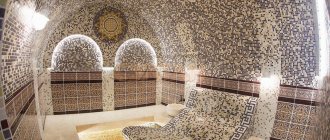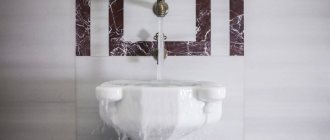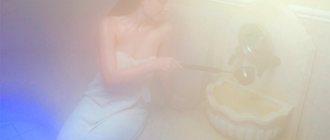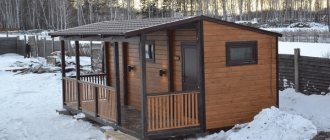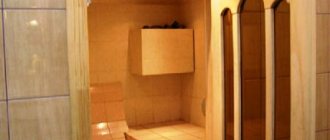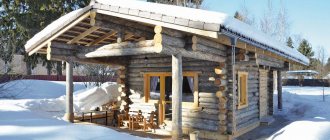The bathhouse has been familiar to people since ancient times.
According to archaeological excavations, the bathhouse dates back to ancient times.
Even then, people were familiar with such concepts as fire and water, and learned to use them correctly.
This became the most important prerequisite for the appearance of the bathhouse.
Humanity quickly gets used to the good and useful.
As a result of migration and the development of more and more new territories by people, different baths with their own characteristics appeared, where people applied and implemented their acquired life experience.
Story
Whatever they say about baths, they are a product of human activity.
Their first appearance was noticed in the 13th century BC.
In ancient civilization, they were heated rooms built of stone.
The main location of baths is in densely populated cities.
They were intended not only for health improvement, but also for spending time in a fun and pleasant company.
By the name of the bathhouse you can determine its origin.
As you probably understand, in this article we will pay attention to the bathhouse, which appeared in Egypt. Even 6 thousand years ago, people took care of the personal hygiene of their bodies and used steam rooms.
Wealthier clergymen washed themselves up to 4 times a day.
Egypt was also famous for its public baths, which could be visited by various segments of the population. For the first time, baths resembled the form of a bathtub, which was made of clay or stone.
And the strangest thing is that it was filled with cold water in which people took water procedures. Then the baths began to improve after the installation of such devices as hearths.
They were located in the basement and, above them, they made stone sun loungers with holes.
This way the sun lounger warmed up. From then on, hot water and steam began to be used in baths for the first time.
The next innovation was the construction of a pool with cool water, in which visitors washed their feet after reclining. The Egyptian bath described above was found during excavations.
It was quite large, as it consisted of 2 floors.
Nearby there were additional rooms with all kinds of medical instruments.
Egyptian doctors have always been considered one of the best.
The steam room for them was the best method of combating illnesses. In the center of the steam room there was a pool with contrasting baths, something like a gymnasium.
After the steam room, the Egyptians spent a lot of time on their health and also tried to keep their figure in shape.
With the help of an Egyptian bath, moderate nutrition and gymnastics, they fought against aging. Residents believed that the purer the body, the closer they were to the gods, so they did not ignore the use of aromatic and essential oils in the baths.
We steamed from young to old. The Egyptians believed that even with great hunger and extreme heat, the body should be clean and fragrant in smell.
Many are familiar with the ancient Egyptian belief that steam can cleanse not only the body and soul, but also relieve sins. The bathhouse helped relieve stress and fatigue.
My bathhouse
In ancient Egypt, baths were part of the pharaonic health program, in modern terms. Priests and healers actively referred patients to the steam room to treat a huge number of ailments. Plus, a whole range of measures put the skin in order, which today can be attributed to the cosmetology industry.
Egyptian baths consisted of two floors. On the ground floor there was a water heating system in huge boilers and other technical rooms. Water vapor from these boilers flowed from the first floor to the second, where stone beds and mud baths were equipped for visitors. Thanks to the continuous operation of the boilers, it was possible to maintain a constant temperature and humidity in all rooms on the second floor. The temperature was maintained between 45 degrees and humidity 50-80 percent.
The whole process of visiting rasul began with ablution. It was necessary to wash away dust and dirt from the body. Next comes the steam room. Here everything is arranged completely differently from the usual Russian bath or sauna. Several baths with healing mud, and different muds were intended for different parts of the body. An additional effect was achieved by adding fragrant herbs to boilers with heated water, which filled the steam room with beneficial aromas.
Constant humidity kept the healing clays in a viscous state, preventing them from drying out. This produced a long-lasting healing effect. You can spend 10-15 minutes in the steam room. Then you need to wash off all the dirt and move on to massage procedures in which various oils were actively used.
The knowledge of Egyptian priests about medicinal compositions can rightfully compete with modern cosmetology. Already several thousand years ago they made various healing mixtures that were used in rasul. They combined various medicinal herbs, essential oils, extracts from plants and algae. And for skin cleansing procedures, these mixtures were mixed with clay, ash or sand.
This technology was borrowed by the ancient Greeks after becoming acquainted with Egyptian culture. Before this, they used round rooms with a fireplace in the center, but water had to be drawn by hand from large containers.
Today, an Egyptian bath does not need to be built on two floors. To equip the technical part, heated floors and electric steam generators are used. And for peeling procedures and massage she uses modern oils and scrubs.
.
Bathhouse rasul
The rasul bathhouse is especially popular.
It is famous for its procedures involving wrapping with healing clay and mud.
The principle of the procedure is that the visitors’ body is thoroughly smeared with clay or mud and placed in a room with a humidity temperature of about 50% and an air temperature of 30 degrees, which is gradually warmed up to 45.
Air humidity is brought to 100%, the room is filled with aromatic oils. Thanks to this procedure, the patient’s skin is cleansed, freed from toxins, and becomes soft and velvety to the touch.
The duration of the procedure is 30 minutes, frequency – 2-3 times a month.
Let's go to Ancient Egypt: rasul bath
At the excavation site of the ancient city of Egypt, archaeologists found fragments of the buildings of two-story baths. On the second floor there were quite massive stone benches, which were heated from the first floor. People sat on these stones, and the bathhouse attendant rubbed their bodies with a variety of useful potions. They also did massages there. There was a hole in the stone through which steam came out. Inhalations in baths were widespread in Egypt. Instead of regular soap, they used a paste consisting of water and beeswax.
In the middle of the second floor there was a small pool, people would plunge into it after a hot steam bath. There was a separate room for gymnastics. Also in the Egyptian bath there was a hall for treating diseases, and it was there that archaeologists discovered various medical devices.
On the floor of the bathhouse there was a water riser that went into the city drain. This drainage system was something like centralized city heating.
And now the most interesting thing: the Rasul bath is the ancestor of the Roman baths, and therefore the Turkish hammam baths, from which the Roman steam baths originated. This is where the tradition of visiting a bathhouse in the East came from!
Some Egyptian bath procedures
A visit to the Rasul bathhouse involves various procedures, including mud therapy and clay treatment. Wraps were offered with the same clay, seaweed and sand. Thanks to the relatively low humidity and pleasant warmth, the visitors' bodies dried out quickly enough. The skin became cleaner, waste and toxins came out of the body. After the procedures, the cabin was gradually filled with the aromas of herbs and steam, the humidity gradually increased, which means the clay was also moistened, resulting in a peeling effect.
The luxury of Roman baths
Special attention was paid to the external and internal decoration of the baths; they personified all the greatness and splendor of the Roman Empire. There were mosaic floors and walls, gold, silver or stone washstands, sun loungers and pools were decorated with marble. Despite the external luxury of the Roman baths, the fee for visiting them was small. Both wealthy people and poor people came here. The boundaries of social classes in the baths were erased, which allowed all visitors to communicate on equal terms.
Modern Roman baths are more compact and not as majestic as before. This is due to the high cost of construction and maintenance. Rich decoration, many rooms, complex communications that constantly require repairs always entail additional expenses. Thermae are no longer centers of cultural communication; they do not have libraries or facilities for sports competitions; they are simply bathhouses where visitors go to wash themselves. But still, the national features of Roman baths are preserved: they necessarily have several rooms in which different humidity and temperature are maintained.
If we talk about the design, the baths are characterized by a Roman style: vaults, arches, columns, antique statues. The walls and floors are also finished with tiles, mosaics or natural stone. Typically, thermal baths are not private property; they are part of complexes of spa centers or large hotels.
Hammam - Turkish steam bath
The Roman Empire, which fell into pieces, was replaced by Arab conquerors. In the 7th century, they owned half the world and, in the process of wars of conquest, also adopted the culture of the absorbed states. Arab nomads appreciated the Roman and Greek baths; they began to build hammams in their likeness.
Hammams (from Ham - hot) are based on the same principles as their predecessors. The boiler was also located under the floor, and steam entered the rooms through holes in the walls. The heating technology has not changed; the Arabs even simplified it somewhat: a boiler with bubbling water was located behind the wall or under the floor, sometimes heating them up to 80 ° C. To prevent overheating, the floors were constantly watered, so the room was enveloped in thick, soft steam.
Arab baths quickly spread throughout the country, helped by Islam. Purity of soul and body was the only virtue of the true righteous.
After the 10th century, the Caliphate gradually collapsed; after 6 centuries, the Ottoman Empire ruled these territories. Today, only Turkey remains. Contrary to the popular belief that hammams are only here, this type of steam room is relevant throughout Asia and North Africa.
Hammams were not as large as their predecessors, but they were decorated no less luxuriously. Turkish baths have safely survived to this day, having undergone virtually no changes. The Prophet Muhammad declared visiting the baths obligatory, since “Cleanliness is half the faith.” Therefore, Turkish baths have spread widely throughout the world.
Large hammams are represented by separate buildings with many rooms, organized according to the palm principle: in the center is a steam room (palm), around it are five niches (fingers). The temperature in the rooms varies from 35-55 oC.
In the dressing room, the temperature is no more than 35 oC; here visitors take off their clothes and warm up slightly, thus preparing to visit the steam room. In the center of the steam room there is a “supa” - a wide marble bench-bed. Literally, “supa” is translated as “flat stone,” another synonym is “chebek-tashi,” that is, “stone for the stomach.”
From the round hall there are niche-fingers running down the center of the structure. Moving from room to room, the bather warms up more and more, reaches the most comfortable state for himself, and then goes to the massage therapist. Turkish bath attendants are real virtuosos; they begin to massage the body from the head, gradually moving to the feet. At first glance, the bathhouse attendant’s movements may seem too harsh, but such sometimes sharp pressure and kneading bring only positive emotions, since the massage therapists know their job very well. After visiting the hammam, a person feels renewed, full of strength, reborn. Such wellness procedures must be repeated regularly!
A little bit of history
Archaeologists claim that the bathhouse is as old as the first human civilization.
When people made the first random experiment with hot air and water, they realized how much benefit and pleasure this discovery could bring them. The construction of a bathhouse and its use for each nation was subject to its own unique traditions.
It is interesting that at first the structures, artlessly made of poles and skins with heated stones inside, were not even intended for washing: in ancient ritual baths this action was turned into a ceremony of communication with the gods.
Among the Slavs and Northerners, the bathhouse is closely associated with witchcraft. From history textbooks we know that ancient baths were centers of intellectual and social life, where concern for the hygiene of body and soul was united.
Wonderful rasul
The main “highlight” of the Egyptian bath is washing with rasul.
Rasoul is the name of the clay, the deposit of which is located in Morocco under the Atlas Mountains. As in ancient times, it is used as an effective hypoallergenic detergent. Rasul perfectly removes dirt along with dead cells without irritating the sebaceous glands and without disturbing the lipid balance of the skin.
The Rasul bath is an impeccable combination of hydro-steam treatments with cosmetic manipulations. Hot steam in combination with healing substances of clay and herbal extracts perfectly cleanses and rejuvenates the skin, penetrating through heated pores into the deep layers of the epidermis. Wet vapors of herbs saturate the body with invaluable microelements.
Egyptian bath Rasul - hydro-steam treatment for soul and body
| Bath Rasul combines the healing traditions of Ancient Egypt and modern technologies |
Probably everyone has heard about the Turkish hammam. But far fewer articles are devoted to the Egyptian bathhouse Rasul than it deserves. And in vain - after all, this is a bathhouse with a history more ancient than Roman baths. The procedures that await the visitor to the Rasul bath organically combine the medicinal traditions of ancient Egyptian civilization, the features of medieval oriental bath pleasures and the latest relaxation technologies.
While vacationing in Egypt, be sure to visit the Rasul bathhouse. An exotic pleasure for body and soul awaits you, guaranteeing a powerful healing effect.
Some tourists, out of ignorance, consider the Egyptian bathhouse to be an analogue of the Turkish hammam. But this is not entirely true. These baths have common features, because the Rasul bath is considered the predecessor of the hamam. And yet, the Egyptian bath has its own unique features.
Design of the Rasul bathhouse
It’s unlikely that you were told in history lessons that the inhabitants of hot Ancient Egypt also took baths. The buildings where the bath complexes were located were built on two floors. The first floor was reserved for technical rooms. It was here that experienced bathhouse attendants created thick and fragrant steam that rose to the second floor. The boilers located on the ground floor were maintained at a constant temperature, guaranteeing uniform heating of the upper rooms.
The Egyptian Rasul bath is called the ancestor of the Turkish hamam.
There was a steam room at the top. It was filled from floor to ceiling with damp puffs of fragrant steam. Here the guests basked in the gentle warmth, reclining on comfortable beds. Experienced massage therapists kneaded the gentlemen's bodies, applied aromatic ointments and ointments to their bodies.
In a modern Egyptian bath, the same steam effect is achieved using modern equipment. Instead of boilers, electric generators are installed in the Rasul baths, and heated floor technology is used.
Historians believe that the ancient Egyptian bathhouse is the oldest in the world. The ancient Greeks became interested in the design of this bath, and then Roman baths appeared. They, in turn, are the ancestors of the Byzantine baths. Well, after the conquest of Constantinople, the Turks began to build their hammams.
Mud therapy in an Egyptian bath
A visit to the Rasul bathhouse promises an acquaintance with a whole range of interconnected bathhouse joys. First, the body is thoroughly steamed so that the muscles relax and the skin becomes more receptive to the application of healing oils and mud.
The second stage is mud. After the shower, the guest lies down on a heated bed, and the bath master selects mud mixtures for him. A special mud “cocktail” is intended for each part of the body. Each of these healing “cocktails” has its own effect: for example, tonic, soothing, disinfectant, cosmetic... These mud mixes also have a peeling effect.
Cleanliness is the key to meeting the gods
The cleanliness and aesthetic views of the Egyptians reached the point of pedantry. Leaving the house without bracelets and a carefully styled hairstyle was the height of shamelessness. Jewelry sparkled in her hair and contained incense. For a resident of Ancient Egypt, cleanliness and health of the body were a reflection of inner perfection, bringing one closer to the gods. According to Herodotus, temple servants performed daily ablutions four times - at midnight, in the morning, at noon and in the evening. Is it any wonder that the Egyptians created the perfect bathhouse?
